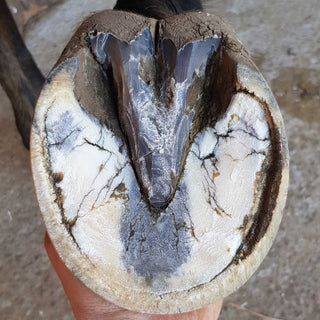What is WLD White Line Disease?
White line disease (WLD) - decomposition of the white line - is caused by anaerobic bacteria and fungi. and is a widespread phenomenon, especially in our latitudes, alongside thrush. Its consequences are wall seperations, seedy toes, loose clinches, abscesses and foul-smelling rot in the sole, frog and corner bar areas.
Hoof areas affected
In bare hoofed horses, WLD occurs in the white line and in the corner bar area. In shod horses, it occurs in the white line under the shoe, mainly in the nail area. Especially when plastic or leather pads are used, but also with snowgrips and glued plastic shoes, no atmospheric oxygen can reach the horn. This provides an ideal environment for putrefactive pathogens to multiply.

Fig. 1: WLD under the still intact horn wall (dark areas in the nail area)
However, the use of hoof packing, e.g. made of silicone, is often absolutely necessary for the treatment and prevention of damage to the hoof or joint area (e.g. laminitis, coffin joint inflammation, low heels). However, decay processes on the frog, white line, corner bars and sole that have already reached an advanced stage often call further use of the packing materials into question.
How do I recognize white line disease in horses?
Symptoms and signs of white line disease
Black discoloration on the horn of the white line is always due to putrefactive pathogens. The soft horn of the white line is much more susceptible to bacteria and fungi, as the pathogens can easily decompose and digest the horn due to its soft and vulnerable structure; the horn of the wall and sole is much more stable in this respect.

Effects of white line disease on horses
Untreated, progressive white line disease can lead to severe wall lesions and even seedy toes and the resulting lameness. The danger is that white line disease can initially only be seen from the sole side and it is not possible to see the extent of the damage . If an incipient seedy toe or keratoma is not recognized or treated it can spread further and further under the seemingly "intact" horn wall.

What are the causes of white line disease?
The cause of WLD is always horn-decomposing germs, symbioses of fungi and bacteria. One reason why so many horses are affected by white line disease is their husbandry: Horses originally lived in steppe-like regions with rather dry climatic conditions. There they moved around on huge areas - rotting of the horn can hardly occur in such an environment. When horses are kept in stables, especially in boxes, they are forced to step in their own excrement, even if they are kept clean. Bacteria and fungi lurk there, which, especially if ammonia has damaged the keratin protein in the horn, find a good breeding ground here.
Ammonia is produced particularly quickly in the warm season by the bacterial decomposition of urea in the horse's urine. The pungent-smelling gas is lighter than air, so it rises from the bedding and combines with moist air. It then sinks back into the bedding as ammonia. Ammonia can damage the keratin protein in the horn as well as the horse's skin and lungs. The now chemically damaged horn is the ideal breeding ground for bacteria and fungi. These decompose the horn, producing decomposition products such as hydrogen sulphide (rotten egg smell), which in turn can dissolve the horn. The result is a process that perpetuates itself like a vicious circle - even over long periods of drought.
How can white line disease be treated?
Procedure for white line disease treatment
First and foremost, a distinction must be made as to whether the horse is shod or barehoofed. A shod horse has the disadvantage that no light or air can get under the shoe. It is therefore just as difficult to get care products under the shod hoof.
Keralit Undercover - the hoof protection under shoe pad and packing
Our paste is suitable for shod horses. Keralit Undercover is applied by the farrier into the cavities of the white line before nailing on the shoe. The well-adhering hoof care paste has been specially developed to prevent horn decomposition processes in the white line, sole, bars and frog areas as well as in keratomas and seedy walls.

Fig. 4: Before nailing on the shoe, the defective areas of the white line are removed and filled with Keralit Undercover
Keralit Undercover releases decay-inhibiting active substances throughout the entire shoeing period, especially if moisture gets under the shoe from the outside, e.g. by washing the hooves or from the bedding. When Keralit Undercover is used, the environment under the shoe or pad and packing is modified in a way that decomposition processes caused by ammonia or microorganisms can no longer prevail. Foul-smelling putrefaction is prevented and the horn is stabilized.
Keralit Undercover is also often used for the treatment and prevention of horn decomposition in the frog area. It is particularly suitable for horses kept in open stables or paddocks, as it remains in the frog clefts for many days and adheres to the frog clefts even in wet weather. Daily treatment is therefore not necessary.
Keralit Hoof Hardener - for barehoofed horses
In the bare hoof you can easily reach the damaged areas of the white line. Here it makes sense to use the Keralit Hoof Hardener from below and from the outside. This stabilizes the horn and counteracts horn decomposition processes.
 Fig. 5: Application of Keralit Hoof Hardener from the outside
Fig. 5: Application of Keralit Hoof Hardener from the outside
Tips for treating white line disease
What to consider when treating WLD:
- Good stall hygiene, sufficient fresh air
- frequently pick the hooves
- Little contact with water, no wet paddocks
- Do not grease damaged areas
- Do not wash with soap (alkaline pH value)
How do I prevent white line disease? Influence of the hoof shape
The hoof trimmer or farrier should always strive for a physiologically correct hoof shape with straight walls so that the hoof walls are bent outwards as little as possible in the lower hoof wall area (trumpet-shaped). Hoof walls that are bent outwards considerably promote white line disease, as the white line is already being stretched outwards at this stage, resulting in cracks and defects. To prevent WLD, it is advisable to ensure good stall hygiene, light, fresh air and plenty of exercise on spatious paddocks. These are factors that all have a positive influence on the quality of the hooves.


